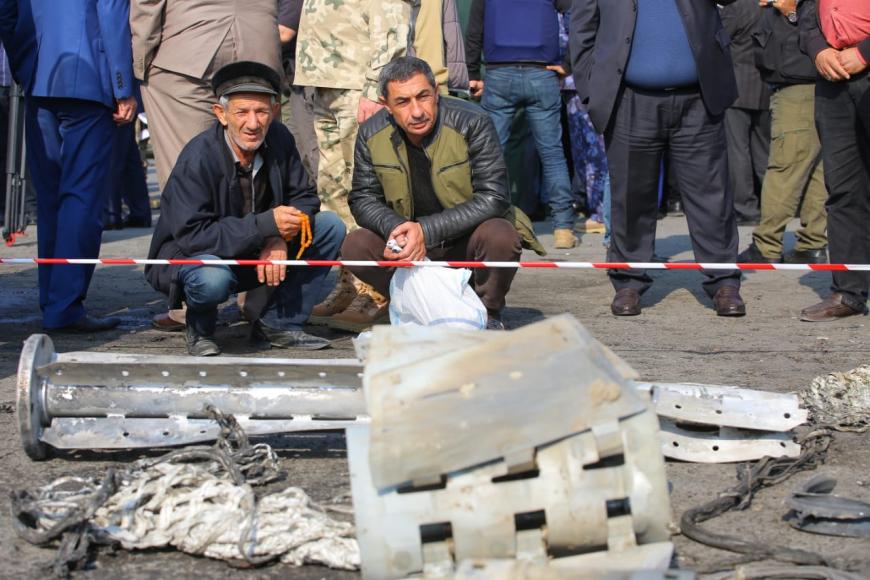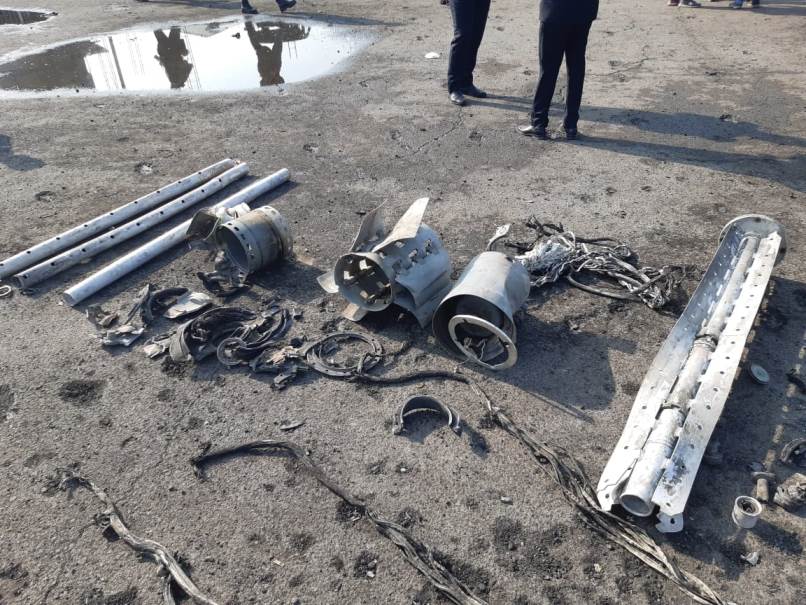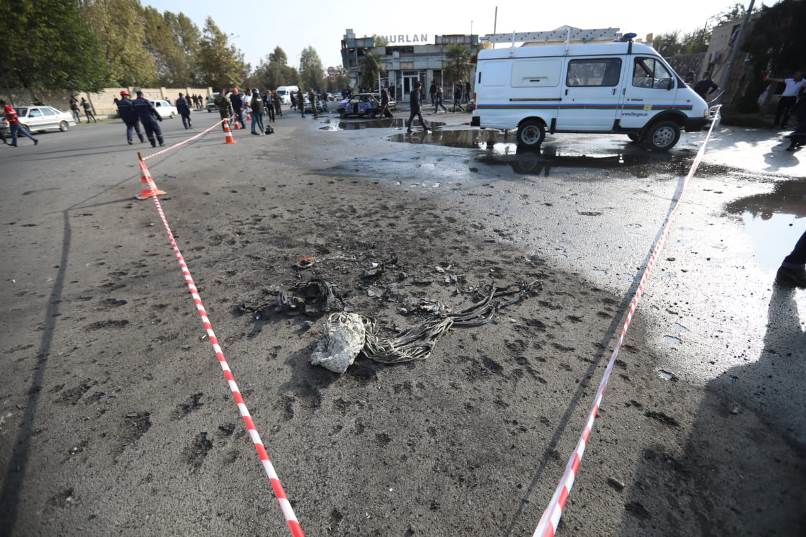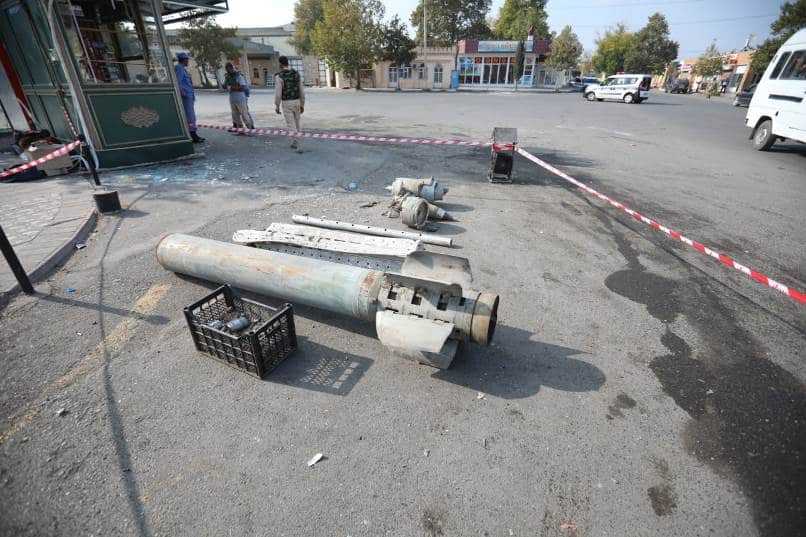
Armenia: Cluster Munitions Kill Civilians in Azerbaijan
30 October 2020
Human Rights Watch, October 30, 2020
Armenian forces either fired or supplied internationally banned cluster munitions and at least one other type of long-range rocket used in an attack on Barda city, 230 kilometers west of Azerbaijan’s capital, Baku on October 28, 2020, Human Rights Watch said today. The attack reportedly killed at least 21 civilians and wounded at least another 70.
Human Rights Watch analyzed photos of cluster munition remnants taken by international and local journalists and residents at and near the attack scene. It identified two of the weapons as a Smerch cluster munition rocket and a Smerch parachute-retarded high-explosive fragmentation rocket. As far as Human Rights Watch is aware, Armenian forces possess Smerch multi-barrel rocket launchers, but Nagorno-Karabakh forces do not. It is therefore likely that Armenian forces carried out the attack or supplied the munitions to Nagorno-Karabakh forces. Armenia should immediately cease using cluster munitions or supplying them to Nagorno-Karabakh forces.

“There’s a reason these brutal weapons are banned by an international treaty, and using them in a city center shows flagrant disregard for civilian life and international law,” said Belkis Wille, senior crisis and conflict researcher at Human Rights Watch. “All countries should condemn using cluster munitions in the war over Nagorno-Karabakh and urge the parties to the conflict to stop using them.”
On October 28, the Armenian Defense Ministry spokesperson, Shushan Stepanyan, said on Facebook that “The statement of the Ministry of Defense of Azerbaijan that the Armed Forces of Armenia allegedly hit the town of Barda with Smerch is groundless and false,” but on October 29 it issued two posts listing military objects allegedly in Barda. While Human Rights Watch has not been on the ground in the aftermath of this cluster attack, given the weight of the evidence discussed below it is improbable that this was a technical failure of multiple weapons.
Fighting between Armenia and Azerbaijan over Nagorno-Karabakh dramatically escalated on September 27. A Human Rights Watch report on October 23 found that the Azerbaijan army used cluster munitions in at least four separate incidents since the fighting began.
Barda has a population of about 40,000. Three people who were in the vicinity of the attack at 1:30 p.m. spoke to Human Rights Watch on October 29 by telephone. All heard a mix of large explosions and “pops” of smaller explosions, consistent with the detonations of the 9N235 submunitions.
One man said the attack killed his cousin and wounded two other relatives. He said that he was about 50 meters away when a cluster munition landed on Uzeyir Hajibeyov Street, a large and busy avenue with much commercial activity.

“After the first explosion I ran for my life and hid by a nearby building,” he said. “I saw four cars go up in flames. I saw the driver stuck inside one of the cars – he died in the fire. The second blast happened after less than five munities and I saw small mini bombs spread out everywhere and start exploding. Then, I heard two other rockets exploding, probably around 300 or 400 meters away from the first blast. Everyone was chaotic and screaming, some were running around covered in blood, and there were dead bodies and pieces of flesh everywhere. I have only seen scenes like this in movies.”
He said that many people walking by at the time of the attack had wounds from metal fragments caused by the explosions. He also said that many buildings and cars were damaged. Another man said he was eating in a café near one of the attack sites and heard six explosions. About 10 minutes after the last explosion, he said, he ventured outside to take photographs. “There were bodies on the ground and wounded people with metal fragments in their bodies, hands, and faces,” he said. “Many buildings were damaged and all the glass in the windows had shattered.”
A foreign journalist said that when he heard the first explosion, he pulled over the car in which he was travelling with colleagues and that they ran out and sought cover. He heard multiple strikes over the next 5 to 10 minutes, and later realized he had been hiding only about 30 meters from an impact site. “It was weird that we weren’t hearing large impacts, instead we heard this popping sound above our heads, that was coming in waves,” he said. “We would hear three or four pops, then a lull of a minute or so, and then another burst of pops. I think that happened about three or four times.”
He said that once the explosions stopped, they drove north about two kilometers, to the site of another blast that occurred at the same time, and saw bodies being taken from a burned car.
None of the witnesses knew of any warning to civilians in the area. “Everyone was caught off-guard,” the journalist said. “It was the middle of the day and we were certainly not prepared for or expecting an incoming attack.”
The Azerbaijan General Prosecutor’s office published the names and ages of 21 people it said were killed and said another 70 were injured. It is not clear if cluster munitions caused all the civilian casualties.
Human Rights Watch reviewed six videos and 28 photographs taken from the scenes of the attack and shared directly with researchers, as well as posted on social media. Human Rights Watch was able to verify the locations of two of the sites attacked by matching key landmarks in the photographs and videos with satellite imagery. One of the locations confirmed was less than 100 meters from Barda Central Hospital, the city’s largest fully functioning hospital.

Remnants of the distinctive warhead section of a Smerch cluster munition rocket and parts of unexploded 9N235 submunitions are visible in the pictures. They also show the remnants of another type of Smerch rocket that uses a unitary blast-fragmentation warhead with a parachute to control its descent before detonating above-ground. The blast and fragmentation damage at the attack scenes and the victims’ visible wounds are consistent with the blast and fragmentation effect from these weapons.
Standard international reference publications, including the authoritative annual Military Balance 2020 by the International Institute for Strategic Studies, do not say that Nagorno-Karabakh armed forces possess Smerch multi-barrel rocket launchers. It does say that Armenia has Tockhka and Iskander ballistic missiles and Smerch and Chinese-made WM-80 multi-barrel rocket launchers, all of which can deliver cluster munition warheads.
The journalist said that while he has seen people wearing fatigues on the street in border towns like Barda, he had not seen any concentrated presence of soldiers or military vehicles on the road before or at the time of the attack. Even if there had been a military object in the area, given the indiscriminate effects of cluster munitions, their use in a residential civilian setting is not permitted under the laws of war.
Cluster munitions are banned under an international treaty because of their widespread indiscriminate effect and long-lasting danger to civilians. They typically explode in the air and send dozens, even hundreds, of small bomblets over an area the size of a football field. Cluster submunitions often fail to explode on initial impact, leaving duds that act like landmines.
The 2008 Convention on Cluster Munitions comprehensively prohibits cluster munitions and requires their clearance and assistance to victims. Neither Armenia nor Azerbaijan is among the treaty’s 110 states parties. Both say that they cannot accede to the treaty until the dispute over Nagorno-Karabakh is resolved. Both should join the Convention on Cluster Munitions without delay, Human Rights Watch said.
Regardless of specific treaty obligations, all parties to the conflict are bound by the Geneva Conventions and customary international law and must abide by the fundamental principles of international humanitarian law, which requires armed forces to distinguish between combatants and civilians, and between military objects and civilian objects, at all times. Indiscriminate attacks or attacks that cause excessive civilian damage compared to the anticipated concrete military advantage are also forbidden.
The laws of war require the parties to a conflict to take constant care during military operations to spare the civilian population and to “take all feasible precautions” to avoid or minimize the incidental loss of civilian life and damage to civilian objects. These precautions include doing everything feasible to verify that the objects of attack are military objectives and not civilians or civilian objects and giving “effective advance warning” to civilians when circumstances permit.
“Both Armenia and Azerbaijan should immediately stop using cluster munitions, destroy their stockpile, and join the Convention on Cluster Munitions,” Wille said.












